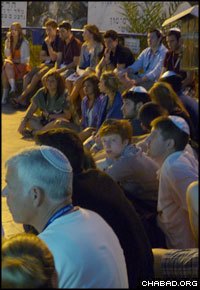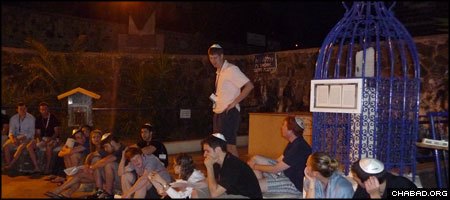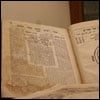TIBERIAS, Israel – A group of American college students and recent graduates earned the distinction of being among the first people in the world to celebrate this year’s completion of the study of the Mishneh Torah, the foundational Jewish law code authored by medieval sage and philosopher Moses Maimonides.
Most of the 80-strong gathering, however, had only that day learned who Maimonides – frequently known in religious circles as the Rambam – was and the importance of his code, which has been studied annually by tens of thousands of people worldwide for the past 25 years. After spending time tackling different portions of the text and the Rambam’s biography during bus rides in between stops on their free Taglit-birthright israel tour of the Holy Land, they congregated at the sage’s resting place in Tiberias, Israel, Tuesday night.
“Jews around the world are uniting together in celebrating Maimonides’ work,” remarked Rabbi Shmuel Tiechtel, co-director of the Chabad-Lubavitch center serving Arizona State University and coordinator of one group of students on the birthright trips provided by Mayanot. “How could we not join in, considering we were going to be here at this time?”
Tuesday night and Wednesday marked the last day of the 27th annual cycle of Mishneh Torah study, which the Rebbe, Rabbi Menachem M. Schneerson, of righteous memory, instituted in 1984 to promote Jewish unity around the globe. The Rambam’s 14-volume work is the only collection of Jewish law that spans all of Jewish life, including those laws that only apply when the Temple in Jerusalem is standing.
Communities around the world began celebrating the cycle’s completion – and the beginning of the next one – Wednesday night.
The students, however, gathered just as the final day began, at nightfall, taking up half of the space underneath a giant wrought-iron sculpture sheltering the Rambam’s resting place. Each one stood up and briefly shared what they learned that day; some explored such topics as honoring one’s parents and the laws of prophets, while others looked at Maimonides’ intricate calculations of the paths of the planets and stars.
“I don’t know much about Maimonides,” said Molly Seltzer, who will begin her senior year at the University of Pennsylvania in the fall. “But to hear everyone’s chapter and their own perspective on what they learned made the exercise so interesting.
“I read about prophecy and prophets,” continued Seltzer, who is majoring in psychology with a minor in English. “One of their characteristics is that G‑d gives them gifts, but Maimonides does not imply that people should believe in a prophet because of this. In a way, they’re determined both by G‑d and the people. That’s pretty cool.”

Ironic Timing
The stop in Tiberias, which followed a day of off-road adventures in the Golan Heights, a tour of Israel’s border with Lebanon and a visit to the Upper Galilee kibbutz of Misgav Av, was the idea of Rabbi Levi Haskelevich of the Lubavitch House of Penn, who led another Mayanot group.
“It was amazing to see everybody get up and share a little bit about Maimonides, and what they felt about what they learned,” said Haskelevich. “It’s one thing for them to hear a rabbi with a beard talk about what the Torah says about the Messianic Era. It’s another thing entirely for them to discover it themselves and then discuss it.”
After their presentations, some members of the group spent a few minutes at Maimonides’ tomb in reflection and prayer.
As he was eating dinner overlooking the Sea of Galilee with his fellow students, Jeffrey Kaplan, a junior at Penn’s Wharton School of Business, looked back on the activity. It was only the second day of the trip, he pointed out, and “on a spiritual level, it was awe-inspiring.”
“I went to a Jewish day school from kindergarten to fourth grade, long enough that I heard about this Rambam, but I had never really learned anything about him,” said Kaplan. “And here we were, among the only people in the world at this time who were at his [resting place]. It’s amazing that we’re here. The timing [of the trip] was ironic.”
Amanda Lewis, a recent ASU graduate from Phoenix, said that, coincidentally, she spent the last year learning about the Rambam’s laws of forgiveness with her rabbi back home. He had suggested the topic as a way to deal with Lewis’ grief after the passing of her mother.
“It really kind of helped me get through it,” she said. “And it’s really unexpected that we ended up coming here.”
Dalila Boclin, a Penn senior majoring in sociology and political science, saw a lesson in her examination of the Rambam’s astronomical calculations.
“I thought that it was interesting that Maimonides derived his scientific findings from Greek sources,” she explained. “It’s easy to look at something that talks about the planets with skepticism,” considering it was written in the 13th century.
That Maimonides explored the spiritual meanings of the celestial bodies made Boclin stop and think.
“What resonated for me is that you have to look beyond the physical, and look at how it influences your life,” she said. “That, in essence, is birthright. It’s a journey.”









Join the Discussion